Contents
What is a tibia fracture?
Fracture of the lower leg – this is damage to the tibia or fibula, and sometimes both of them, due to the excess of a load on them greater than they could withstand. The injury is quite common, and on average accounts for approximately 20% of the total number of fractures.
The lower leg is represented by two tubular bones, each of which has a body and two ends. The tibia connects to the femur at the top and to the bones of the foot below. During a fracture, most often the bone, both large and small, breaks in the middle. Sometimes injuries come with complications. Most often, people with such a problem turn to the emergency room after suffering a car accident. Although the cause of the fracture can be any direct and strong blow to the bone. Sometimes an additional factor that plays a role in the formation of a fracture is a disease: sarcoma or osteomyelitis.
There are several types of leg fractures, depending on their location:
Injuries to the neck and head of the fibula, as well as fractures of the tuberosity and condyles of the tibia. When these zones suffer, they talk about fractures of the bones of the lower leg in the upper part.
If the diaphyses of both bones or one of them are injured, then they speak of fractures of the lower leg in its middle part.
If there is a fracture of the ankle, then they speak of a fracture of the tibia in the lower part. This type of injury is the most common and accounts for more than 60% of the total number of all fractures in this area.
Also, the injury can be open or closed, with or without displacement. Depending on its nature and complexity, the method of treatment, as well as its timing, will depend. The severity depends on whether there is damage to the surrounding soft tissues, whether the joints, blood vessels, nerve endings and tendons are injured. Minor injuries, as a rule, are caused by careless movement on the street, skating, industrial accidents. Severe injuries are the result of a fall from a height, participation in an accident, etc.
Displaced tibia fracture
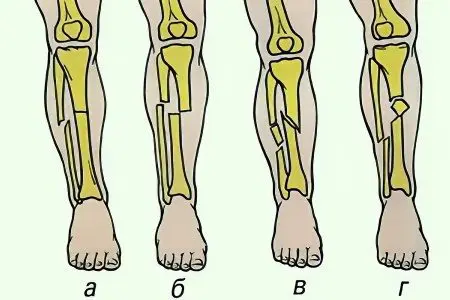
A fracture of the lower leg, in which displacement occurred, is most often formed as a result of a direct blow in the transverse direction. In this case, fragments are formed that can move in different directions. Displacement can be lateral, peripheral, angular, with divergence, wedging and recurrence of broken parts.
Such an injury is characterized by the following symptoms:
The length of the leg will become smaller compared to a healthy limb. Most often, this does not even require additional measurements. The difference will be visible to the naked eye.
The movement of the lower leg can be carried out in an unnatural direction for it.
Sometimes fragments can shift so much that they break through soft tissues and skin.
Sometimes a recess or depression is formed in the place where the movement of the fragments occurred.
Pain is an invariable companion of any fracture, as well as a crunch during an injury.
In the place of localization of the fracture, bruising and swelling are formed, with a pronounced violation of the motor function of the limb.
Most often, the condition of a person who has received a fracture of the lower leg with displacement is still satisfactory, but sometimes traumatic shock can be observed.
Treatment will begin with a mandatory comparison of the resulting fragments. This is necessary to give the limb the correct shape and its subsequent normal fusion. Reposition is carried out either manually or with the help of special tools. To do this, the victim must be laid on his back and anesthetized with appropriate drugs. After that, one doctor holds the patient by the thigh, and the other grabs the leg in such a way that one hand firmly holds the heel, and the second the back of the foot. Then, a slow and systematic stretching of the muscles pulled up to the fracture site is carried out, and at the same time, with the help of probing, the position of the fragments that have undergone displacement is determined. After the reduction is completed, the doctor will definitely check the length of the limb and compare it with the length of a healthy leg. If the parameters converge, then you can start applying a plaster cast.
For control, the patient will have to undergo an X-ray again after 10 days, so that the doctor makes sure that the fusion of the bones of the lower leg is normal. Sometimes a skeletal traction method can be applied. An operation is required when closed reduction cannot be performed, due to the fact that the fixation of fragments requires the use of metal constructions.
Features of the treatment of elderly people, as well as young patients who have received a shin injury with displacement, are that they must be left immobilized for the shortest possible time. That is why you should choose the least traumatic method of treatment.
Fracture of the lower leg without displacement
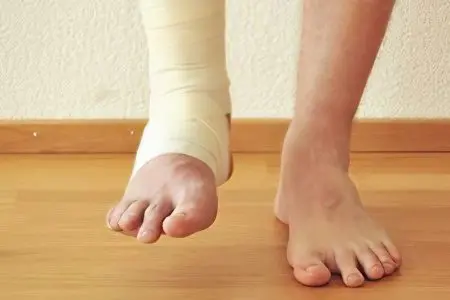
A fracture of the lower leg without displacement is a serious injury, but it proceeds somewhat easier than a similar injury, but with fragments that have come into motion. Often such fractures are subperiosteal, that is, when the whole periosteum from above holds the fragments remaining inside. The age group that is more likely to experience this type of injury is children. This is explained by the fact that their bones are more elastic compared to the bones of adults. Doctors often refer to an injury without displacement as a greenstick fracture.
Symptoms of a fracture of the lower leg without the formation of fragments are as follows:
Swelling at the site of injury.
Painful sensations.
Shortening of the limb, but not pronounced. It will be possible to notice it only after carrying out certain measurements.
Hematoma formation.
Difficulty in mobility.
irradiation symptom. When pressing on the leg anywhere, the pain will be localized exactly where the fracture occurred. It is this symptom that helps in most cases to make the correct diagnosis yourself.
Often, with such an injury, people try to continue moving on their own, as they believe that they just have a severe bruise. Such carelessness is dangerous because, as a result, the fragments that the periosteum holds can begin to move. This will aggravate the severity of the injury and prolong the treatment time. Therefore, at the slightest suspicion of a fracture, it is necessary to see a doctor. Because without an X-ray examination, it is very difficult to diagnose such an injury.
With a closed isolated fracture of the leg bones without displacement, reposition is not needed.
It will be enough to apply a plaster cast, which will be placed in the area from the foot to the knee, or slightly higher – to the middle of the thigh:
If the fibula is broken below, then the plaster will be applied up to the knee.
If the fracture is localized in the middle or in the upper third of the bone, then the imposition of a plaster splint is indicated. It may be removable. Fixes the fracture rigidly, without the possibility of movement.
Most often, immobilization lasts about three months. If the diaphyses of both bones were broken, then the period may increase to 4 months. After removing the plaster, the most common procedures are shown: exercise therapy, massage, physiotherapy. The opportunity to start working duties will appear after 14 – 30 days, as the plaster will be removed.
Open and closed fracture of the tibia
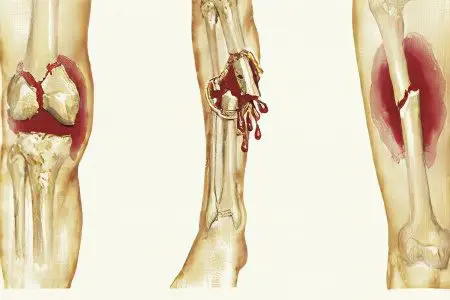
Closed fracture of the tibia
A closed fracture of the tibia is a very serious injury. It is characterized by the fact that damage to tissues located far from the bones does not occur, just as there is no contact of the damaged area with the external environment.
With closed fractures, the bones of the ankle, the condyle of the tibia may suffer, its tuberosity may be torn off, the head of the fibular bone or the diaphysis of both bones may be damaged. If the distal end of the lower leg is damaged, then the fracture can be both intraarticular and periarticular.
The symptoms of a closed fracture are as follows:
Severe limitation of limb mobility. The person will simply not be able to lift his leg up.
If an attempt is made to slightly raise the lower leg, then the end of the tibia (proximal) will protrude under the skin.
If crepitations, that is, characteristic crunches, are heard during palpation, then this symptom clearly indicates the presence of a closed fracture. In this case, you should not cause the sound on purpose, since such manipulations can lead to displacement of fragments that may be under the skin.
If in patients who have not reached retirement age, closed fractures are more often split, since the bones have a solid structure, then in older people, injuries are depressed, which occurs due to the high porosity of bone tissue.
Diagnosis, as a rule, is not difficult for an experienced doctor, and palpation examination is enough for him to determine a closed fracture. This is due to the fact that the bones of the lower leg are located close to the skin and are not covered with a thick layer of muscles. However, X-ray examination is indispensable. It will reveal the characteristic features of the fracture, possible displacement of fragments. Pictures must be obtained in several projections, most often in two.
Treatment is carried out in a hospital. The tasks that doctors face are restoring the integrity of the bone, relieving pain, returning the patient to normal life, which will proceed without restriction of movement.
The following methods are used for this:
Extension, which involves stretching the damaged bone. It can be skeletal or adhesive.
fixation method. It is implemented by applying a certain type of plaster cast.
An operative method that involves intraosseous fixation using either metal plates, or metal knitting needles, or metal rods, or metal wire.
But, of course, before this or that method of fixing the limb is applied, it is necessary to reposition the fragments, if any. Often, a Delbe bandage is used to immobilize the fracture site. It has a number of advantages over conventional plaster, since after its application, a person can move the knee and ankle joints if they are not damaged. This dressing allows outpatient treatment, without the patient being tied to a hospital bed.
Open fracture of the tibia
If open fractures of other bones of the human skeleton are a relatively rare phenomenon, then with a fracture of the lower leg they are much more common, which is quite explainable by its anatomical features. The tibia itself is located directly under the skin, so it often breaks through it with sharp edges, which leads to an open fracture. In addition, if the injury was received as a result of an accident, then it is heavily contaminated. This circumstance greatly aggravates her character.
The main symptoms of open fractures of the lower leg include:
Bleeding.
A gaping wound with bones that have broken through the skin and soft tissues.
Traumatic shock.
Restriction of mobility.
Sharp pain.
Weakness and dizziness, up to loss of consciousness.
The most difficult therapeutic effects are injuries of an open type with the formation of splinters. This is due to the fact that nearby nerves and blood vessels are damaged. Sometimes the question of the need to amputate a limb may even arise.
The decisive factors are:
How extensive is the area of tissue damage.
What is the degree of circulatory disorders of the foot and lower leg.
No pulsation.
The area of damage to the skin. If it is very extensive and it is not possible to replace it, then this will become a decisive factor in favor of amputation of the limb.
The longer the decision to amputate is made, the greater the risk that gangrene may develop. Treatment of any open fracture must be carried out as soon as possible. After its implementation, the introduction of several drainages is shown. It is more expedient to pass them through the holes made for this purpose. The wound should be fixed with a rare suture.
When an open wound is not formed immediately, but as a result of a puncture by the edge of a fragment, and is secondary, then after treatment with antibacterial compounds, sutures are immediately applied, and drainage is not required to be inserted.
When a secondary wound is accompanied by damage to the skin in a large volume, then its transplantation is necessary. It is impossible to separate it from the fabric for the purpose of stretching. Another important feature with an open fracture is that the fragments must be set immediately after treatment with disinfecting compounds, but in no case vice versa. Because it can lead to blood poisoning. In modern medical practice, the use of osteosynthesis is increasingly indicated, which is also performed after the disinfection of an open injury.
If the fracture is transverse, then one reduction will be sufficient, as a rule, the fragments are securely held. If the fracture is oblique or helical, then up to two sutures should be placed with fixation on the wire.
Also, in the treatment of open fractures of the lower leg, there is a tendency to insert a special metal rod inside the bone. It is empty inside, and has holes on the sides. Through it, special medicinal substances, including antibiotics, will be supplied to the bone marrow canal. After its installation, the imposition of gypsum is shown.
The prognosis for limb recovery after an open fracture of the lower leg largely depends on how well the primary antiseptic and antibacterial treatment was carried out. Proper immobilization of the limb plays a significant role. Treatment after the application of plaster is carried out similarly to therapy for a closed fracture, but it is natural that open injuries heal over a longer period of time.
First aid for a broken leg
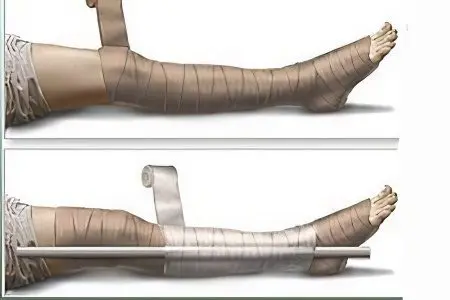
There is a certain procedure that must first be provided to a person who has received a fracture of the lower leg:
To begin with, he needs help to overcome pain symptoms. To do this, you need to give the victim an anesthetic. For this, any drug that is available is suitable. As suitable means, they distinguish: Pentalgin, Analgin, Nimesulide, Sedalgin, etc. If you have medical skills, you can make an intramuscular injection, which will work much faster. Lidocaine, Novocain, Ultracan and other agents are used as suitable drugs. The closer to the fracture site the injection is made, the stronger the analgesic effect will be.
Then shoes should be removed from the limb that was injured. This is done so that as a result of the resulting edema, blood circulation in the limbs is not disturbed. Also, tight shoes will definitely lead to the fact that the pain in the leg will only intensify. If in order to undress the victim, it is necessary to move his leg, then this should be done according to certain rules. It is important to hold the limb in two places: in the ankle and knee joint.
If there is bleeding, then it must be stopped, while the edges of the wound must be treated with any available antiseptic. In order to determine the degree of damage, it is necessary to cut the layer of clothing under which the injured limb is located. In the presence of bleeding, it is important to determine the degree of its danger. If blood flows out in a powerful stream, then this is a sign of damage to a large vessel. To stop it, you will need to apply a tampon to the wound, which can be made of cotton wool or a bandage. A bandage should be applied over the resulting layer, but it should not be pulled too tight. A tourniquet is not recommended for such injuries. This is due to the fact that the muscles under it will stretch, and if fragments form during the injury, they will undergo even greater displacement. In addition, there is a risk of damage to other vessels by sharp edges and increased bleeding. If the blood does not flow from the wound, but simply oozes slowly, then the swab should not be applied. Its antiseptic treatment will be enough. Suitable means such as: Hydrogen peroxide, Potassium permanganate, Zelenka or Iodine, as well as any alcohol-based liquid. Only the edges of the wound are subject to treatment; it is impossible to pour any composition into it.
The leg should be fixed by applying a splint. This is one of the most important steps in first aid. The shin will need to be securely fixed. Splinting is necessary so that the injured limb is immobilized during transportation, since any movement of it can aggravate the injury, damage the nerves and blood vessels, ligaments and muscles. To apply a splint, you will need fabric bandages and any two straight and long objects, such as an umbrella, a board, or a strong stick. They will need to be placed on the outside and inside of the leg. The retainer should end at the heel, and start approximately from the middle of the thigh. Then they need to be bandaged to the leg in several places, but always in the knee and ankle joint. The wider the bandage, the more secure the fixation will be. In this case, the victim should be in the supine position.
After these activities are completed, you must go with the victim to the nearest medical facility or wait for the arrival of the ambulance.
Treatment of a broken leg
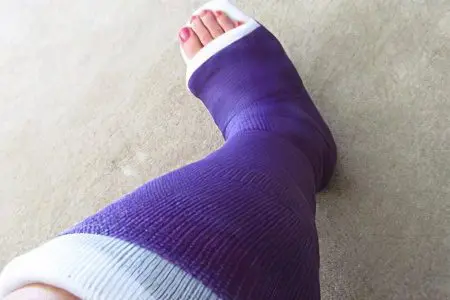
Fracture of the bones of the lower leg can occur in different places. At the same time, fracture therapy methods are used for treatment, but in different combinations. However, the sequence of medical care is always the same.
Therefore, we can formulate several principles for the treatment of a fracture of the lower leg:
Initially, reposition of bone fragments is always performed. It is performed under local anesthesia and only by a surgeon. This is done with the help of skeletal traction, or during the operation.
Then the bone fragments are subject to reliable fixation using one of the most suitable devices.
Then requires immobilization of the limb. For this, a plaster cast or a specialized apparatus is used.
Naturally, in a certain case, specific devices are used that are optimally suited for the treatment of each patient. The choice remains with the traumatologist or surgeon.
Immobilization in case of fracture of the tibia
Immobilization of the lower leg is important to perform according to several rules:
When applying a splint, it must be fixed in such a way that both joints: the knee and ankle are immobilized.
Before the splint is applied, it should be corrected for the size of the broken limb. It is necessary to do this not on the injured person, but on yourself, so as not to cause him unnecessary suffering and not aggravate the severity of the fracture.
Do not put a splint on a naked body. Clothing, if necessary, should be cut, but not removed.
If there are sharp edges and protrusions, then they must first be wrapped with a soft cloth.
If the fracture is open, then the splint is not applied on the side where the protrusion of the bone is visible.
It is better if immobilization is carried out by two people. At the same time, one person should carefully hold the limb, and the second should bandage the retainer. This must be done carefully, but tightly. If the toes were not injured, then they should not be bandaged. This will allow you to control blood circulation and, if it is disturbed, relax the bandages.
Sometimes it happens that it is not possible to find any improvised material. Then you should bandage one leg to the other.
Surgery for a broken leg
Surgery for a fracture of the lower leg is not required too often and there are clear indications for it, among which are the following:
If reposition is not possible without opening, using conservative techniques.
If there is a double fracture of the tibia and there is a significant displacement of the fragments.
If the position of the soft tissues is greatly changed.
If there is a high risk of transition of a closed fracture to an open one, or if the nerves and vessels are compressed by the resulting fragments.
The open nature of the injury.
When a fracture of both bones of the lower leg is observed and an operation is needed, then it is carried out on a more massive bone, since the smaller one will subsequently grow together on its own. When carrying out reposition, preference is given to fixing fragments with the help of metal structures in the case when the bones do not grow together or, pseudoarthrosis of the bone is detected. In other cases, it is advisable to use specialized devices, for example, Tkachenko, Ilizarov, etc.
Rehabilitation after a fracture of the lower leg
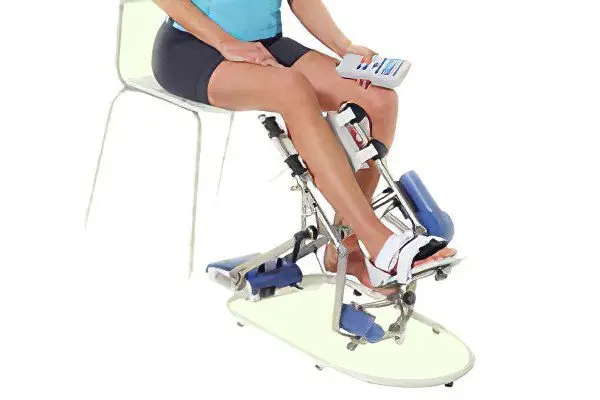
Rehabilitation after an injury is an integral part of the process aimed at restoring the functionality of the limb.
Its goals are:
Prevention of atrophy of the muscles of the leg and thigh.
Restoring their tone, increasing elasticity.
Improving blood circulation, bringing it to a state preceding the injury.
Return of mobility to the joints of the lower leg and knee.
Removal of puffiness and elimination of congestion that can form in the soft tissues of the lower leg.
Activation of limb mobility.
In order for rehabilitation to be as successful as possible, a combination of such techniques is required:
exercise therapy. The patient must do the exercises every day. In this case, the load and the number of approaches will be determined by the attending physician.
Therapeutic massages and rubbing. These procedures should also be carried out daily, as they are an excellent way to eliminate stiffness in the joints, prevent tissue scarring and prevent calf muscle dystrophy.
Physiotherapy, which helps to relieve inflammation, accelerates the healing process, improves metabolism and normalizes blood flow.
Follow a diet that prioritizes foods rich in calcium.
The whole process of rehabilitation after a fracture of the bones of the lower leg is divided into three stages. These include:
At the beginning, as soon as the plaster is removed, massage and rubbing of the limb are shown. It is better if special creams and ointments are used for this. They should include components that help restore damaged tissues and increase blood circulation. For example, it can be Chondroxide ointment. Useful baths with the addition of salt, as well as wax wraps. Exercises should not be started at this time, as this can cause pain. But at the same time, you can not leave the leg completely motionless. It is necessary to move the foot, raise and lower the limb, bend and unbend the knee.
The second stage aimed at restoring the normal functioning of the limb. To do this, massage and baths should be supplemented with a set of exercises. They become more active, there may be leg swings, long walking, rolls from toes to heels, circular leg rotations, etc. It is important to perform the complex daily, omissions will lead to slower recovery. In this case, the exercises should be alternated, for example, by the days of the week. Walking should become regular. The more distance you can cover, the better.
The third stage is final. At this time, you can perform full-fledged sets of exercises, without any restrictions.
Correction of the diet is a prerequisite for a speedy recovery. Products such as: milk, fish, nuts, sesame seeds, raspberries, cauliflower, radishes and other vegetables should be present on the table regularly.
It should be understood that only competent treatment and full-fledged rehabilitation will help a person restore the functions of a limb completely, and also prevent complications from developing, for example, leg deformity, the formation of a false joint, bone curvature, etc.









